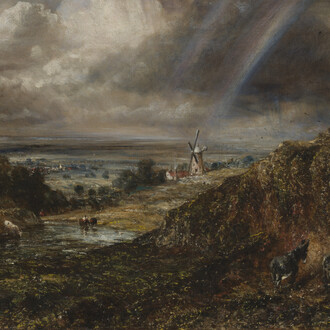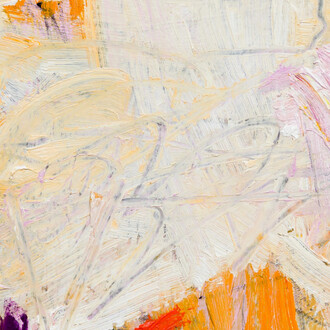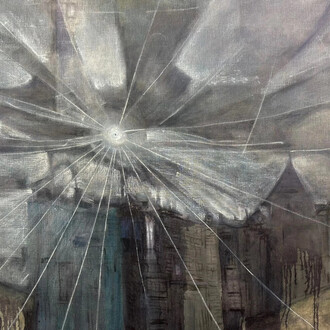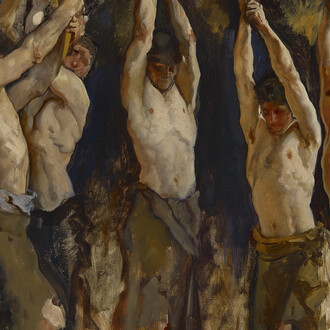Pippy Houldsworth Gallery is pleased to present a solo exhibition of new drawings by British artist Rachel Goodyear titled Approaching the Surface. Referencing unusual and psychotic scenarios, the work in the exhibition captures the sensation of fragmented memories and unconscious fears slowly emerging from the psyche. A newly commissioned text by Philomena Epps, recent writer in residence at Jerwood Visual Arts, London, accompanies the exhibition. Following solo shows at Yorkshire Sculpture Park (2011); The Drawing Center, New York (2015-16) and The Lowry, Manchester (2016), Goodyear is currently preparing for a forthcoming solo exhibition at The New Art Gallery Walsall (May 2017).
Peeling Back the Wallpaper of the Psyche: On Rachel Goodyear’s ‘Approaching the Surface’
'I used to lie awake as a child and get more entertainment and terror out of blank walls and plain furniture than most children could find in a toy-store.'
Charlotte Perkins Gilman, ‘The Yellow Wallpaper’, 1892 In the proto-feminist text ‘The Yellow Wallpaper’, Charlotte Perkins Gilman interweaves female subjugation and hysteria with elements of the Gothic uncanny. The plot challenged and critiqued the ‘idealised’ vision of women in nineteenth century America. With nothing to stimulate her while stuck in the domestic ennui of her summer residence, the narrator becomes obsessed with the pattern and colour of the wallpaper. This obsession descends into psychosis; she starts to perceive women creeping and crawling behind the patterns, later believing that she is one of them. The intensity of the descriptions - the manifestation of oppression as intricate wallpaper patterns and the use of layers as a metaphor for the dark places within the mind – resonates with the work which features in Rachel Goodyear’s show ‘Approaching the Surface’. Indeed, Gilman’s ability to simultaneously create terror and beauty is diffused across the artist’s entire oeuvre. Inspired by the literary Gothic tradition, notably Edgar Allan Poe, and the dystopian fictions of Margaret Atwood, Goodyear is engaged with producing emotional tension. Akin to her artistic influences, significantly Louise Bourgeois and Marlene Dumas, Goodyear relies on the imagination of her viewers. The works in ‘Approaching the Surface’ are psychologically charged, evoking fragmented memories, unconscious fears, and the slippery nature of memory.
‘Approaching the Surface’ marks an important new phase in Goodyear’s practice. In recent years, Goodyear’s work has been following a consistent rubric. Her solo shows at The Drawing Center, New York (2015) and The Yorkshire Sculpture Park (2011) showed drawings completely stripped of background, often with recurring familiar characters. Works such as Woodman (2011) and Afternoon (2011) exemplify a heavy use of animal imagery and references to mythology. Conversely, the subjects of this exhibition are predominantly women and girls. These figures span various periods of history, conflating the Victoriana with references to film noir and silent early German Expressionist films, elucidating Goodyear’s preoccupation with both pioneering cinematic tricks and their association with memory and echoes of the past.However, one of the most notable differences is that the drawings are no longer surrounded by large expanses of white space. Instead, Goodyear has introduced pictorial space and scale; placing the characters within empty rooms or against abstract washes of ink and watercolour. Relinquishing the level of control necessary to create a detailed pencil drawing has allowed the work to develop in a more fluid way. In addition to the fragility of previous pencil-based work, the unruly nature of ink adds a dimension of playfulness and unpredictability. The edges of the paint are left visible, revealing heavier drags of the brush, drips, and layers of pigment. The presence of these layers relates to Goodyear’s fascination with abstraction and fragmentation. Characters emerge and disappear from the anonymous dark backgrounds, evoking sentiments of unease.In a vein not so dissimilar to Francis Bacon’s emblem of claustrophobia - the trademark box - Goodyear’s device of pictorial space also underlines a sense of psychological intensity and isolation.
The surrounding darkness can also be conceived as the blind spots in an individual’s memory. Sigmund Freud’s writing, particularly the relationship between the id, ego and superego, is another influence for Goodyear. One can read how Freud’s fascination with the present’s relationship to the past, investigating what we cannot remember or perhaps deny to ourselves, has a bearing on the works in this exhibition. In Travellers (2016), for example, the hooded subjects hint to periods of history without being pinned to a specific era. Similarly, the allusion to coming-of-age in Girl in a White Dress (2016) depicts an ambiguous bride, bridesmaid, or even a rose-queen, contemplating the expectations of her future.The notion that each subject has a prior history, and how subjectivity is built from an elusive or estranged experience, mirrors Goodyear’s conception of her drawings as fragments from the unconscious. In ‘Between Memory and History: Les Lieux de Memoire’ (1989), Pierre Nora writes that memory “relies entirely on the materiality of the trace, the immediacy of the recording, the visibility of the image”. The recurring theme of vision and visibility is a motif that has continued from the artist’s older work into the new. Goodyear’s work deliberately creates mysterious obstacles for the viewer. The covering of character’s eyes with blindfolds or other abstracted spiky forms engages with distorted memory and the instability of perception. The overlay of inky marks or collaged elements places an obscure barrier between the subject in the drawing and the viewer while the lack of eye contact creates distance.
Analogous to Gilman’s evocation of the wallpaper as a manifestation of emotional turmoil, Goodyear’s use of collage and material layering symbolises an interest in emotional layers of thoughts and recollections. Playing with source material - from old magazines, books, anonymous photographs and cuttings - is the starting point for each work. Blurring contexts, resources and previous works inspires the next activity - a period of stream of consciousness sketching and collaging. By mixing different eras within the works, rather than being rooted in one particular period, an intangible dream-like environment can be summoned. Goodyear perceives the muddling of eras as events or memories that have been etched over time. The frame of the image is akin to an old room, filled with the echoes of historical presences and happenings. Through injecting themes of identity and memory, a sense of melancholy, longing, and searching prevail.
Rachel Goodyear is a British artist who produces drawings and films that explore the macabre undertones of human existence.
Tipped as one of the ‘Future Greats' by Art Review in 2008, Goodyear went on to be shortlisted for the Northern Art Prize in 2009. She had a major solo exhibition at Yorkshire Sculpture Park, Wakefield in 2011 and participated in the Curitiba Biennale, Brazil in 2013. She has recently been part of group shows at Museum Folkwang, Essen; ICA, London; Tate Liverpool; The Drawing Room, London; Nassauischer Kunstverein, Wiesbaden; Collective Gallery, Edinburgh; Manchester Art Gallery, Manchester; Contemporary Art Society, London; Cornerhouse, Manchester; ME Collectors Room, Berlin; Leeds City Art Gallery; Neue Galerie, Innsbruck and Walker Art Gallery, Liverpool.
Goodyear’s work is represented in many international collections including the Victoria & Albert Museum, London; Olbricht Collection, Essen; Walker Art Gallery, Liverpool; Whitworth Art Gallery, Manchester and Museum Folkwang, Essen. Her work currently features in Portraits at The Whitworth Art Gallery, Manchester and Mir ist das Leben lieber, Museum für Modern Kunst, Weserburg.
She recently completed a residency and solo project at The Lowry, Manchester in September 2016.



















